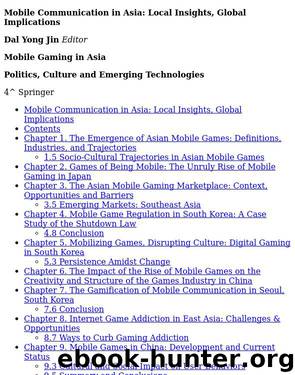Mobile Gaming in Asia by Dal Yong

Author:Dal Yong
Language: eng
Format: epub
7.6 Conclusion
As the present study relied on qualitative interviews from a small sample to explore the meanings of gaming and gameful communication practices amongst smartphone users, further studies into the structural factors behind the emerging gamification of mobile communication can be beneficial. A study of the political economy of online gaming culture in Korea can be conducted. For example, we may examine how the national ICT (Information and Communication Technology) industries’ transition to a mobile platform-based economy (from a sedentary content-based economy) is articulated with the neoliberal, yet paternalistic, state’s cyber-policing in the 2010s. Acknowledging the need for future research, the present study provides valuable insights into how young people appropriate mobile media to redefine urban space as a more manageable site.
This chapter has explored how mobile communication adopts gameful elements and is thus gamified by analyzing young people’s account on their use of mobile (gaming) apps and smartphones. Mobile gaming blurs the boundaries between gaming and ordinary lives and, more specifically, gaming and communication. Currently, smartphone-mediated communication, mobile gaming, and social media use are largely intermingled with each other. The intermixture implies the ever increasing gamification of everyday communication (Hjorth 2009). Various mobile games have increasingly become popular add-ons on smartphones, and many of them have offered casual involvement in gaming in daily moments, such as commuting, waiting, and eating times. In particular, social networking platforms, such as Facebook and Kakao, often link smartphone users to casual games.
By appropriating gameful apps on the smartphone, young people in the study seemed to cope with urban space, time, and sociality. However, their coping strategies did not necessarily involve vibrant engagement with the physicality of the urban context. That is, the gameful appropriation of urban space via locative mobile media often seemed to allow them to ‘remove themselves’ from socio-cultural relations of urban space (Bull 2007: 28). The young people were keen to use the gameful apps to enhance the efficient management of their everyday lives. They tended to think that they were in control of the technology and the rhythm of their everyday lives. By seeking self-disciplinary control of gameful media, the young people seemed to implicitly or explicitly distance themselves from the stereotypical gamer as an anti-social addict. While the young people attempted to appropriate gameful technology as a manageable medium, the technology also appeared to function to manage the young users as self-disciplinary subjects.
Gamification can be seen as a mediated process by which the mobility and freedom of individual users are reorganized and controlled (Schrape 2014). In contrast with some young people’s accounts of mobile gaming practices as the process of self-management, there was little evidence of the ‘subversive capacities of play’ (Sicart 2014: 74) in the seemingly accelerated process of gamification. In this respect, the gamificiation of mobile communication amongst the young people in the study might mean a technologically mediated form of pseudo-play, rather than play as ‘being in the world, of making sense of it’ through engaging with objects and others (Sicart 2014: 18).
Download
This site does not store any files on its server. We only index and link to content provided by other sites. Please contact the content providers to delete copyright contents if any and email us, we'll remove relevant links or contents immediately.
Algorithms of the Intelligent Web by Haralambos Marmanis;Dmitry Babenko(8519)
Test-Driven Development with Java by Alan Mellor(7357)
Data Augmentation with Python by Duc Haba(7254)
Principles of Data Fabric by Sonia Mezzetta(6999)
Learn Blender Simulations the Right Way by Stephen Pearson(6935)
Microservices with Spring Boot 3 and Spring Cloud by Magnus Larsson(6769)
RPA Solution Architect's Handbook by Sachin Sahgal(6170)
Hadoop in Practice by Alex Holmes(6028)
The Infinite Retina by Robert Scoble Irena Cronin(5874)
Jquery UI in Action : Master the concepts Of Jquery UI: A Step By Step Approach by ANMOL GOYAL(5869)
Big Data Analysis with Python by Ivan Marin(5695)
Life 3.0: Being Human in the Age of Artificial Intelligence by Tegmark Max(5399)
Pretrain Vision and Large Language Models in Python by Emily Webber(4656)
Infrastructure as Code for Beginners by Russ McKendrick(4441)
WordPress Plugin Development Cookbook by Yannick Lefebvre(4170)
Functional Programming in JavaScript by Mantyla Dan(4121)
The Age of Surveillance Capitalism by Shoshana Zuboff(4112)
Embracing Microservices Design by Ovais Mehboob Ahmed Khan Nabil Siddiqui and Timothy Oleson(3959)
Applied Machine Learning for Healthcare and Life Sciences Using AWS by Ujjwal Ratan(3933)
